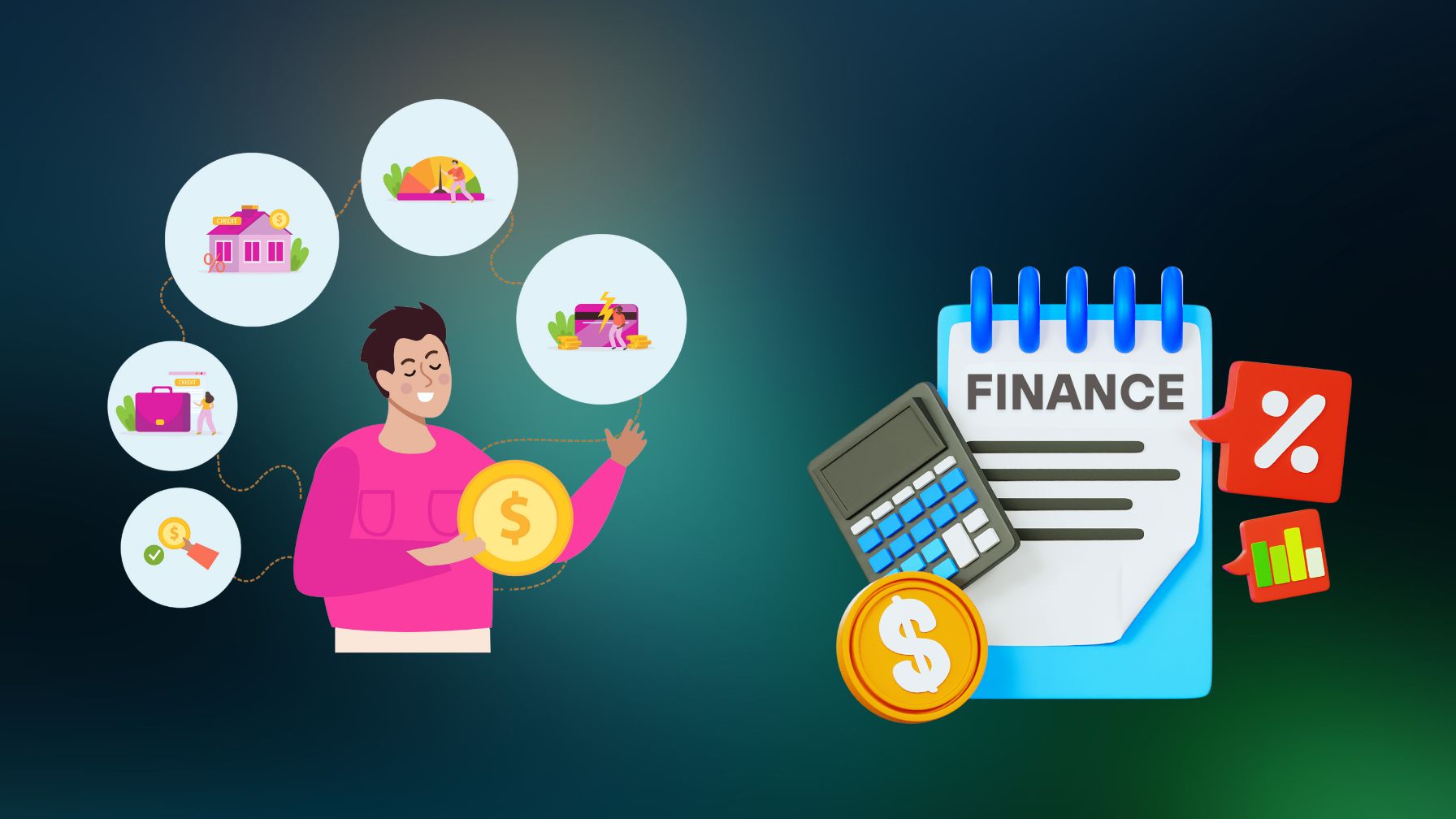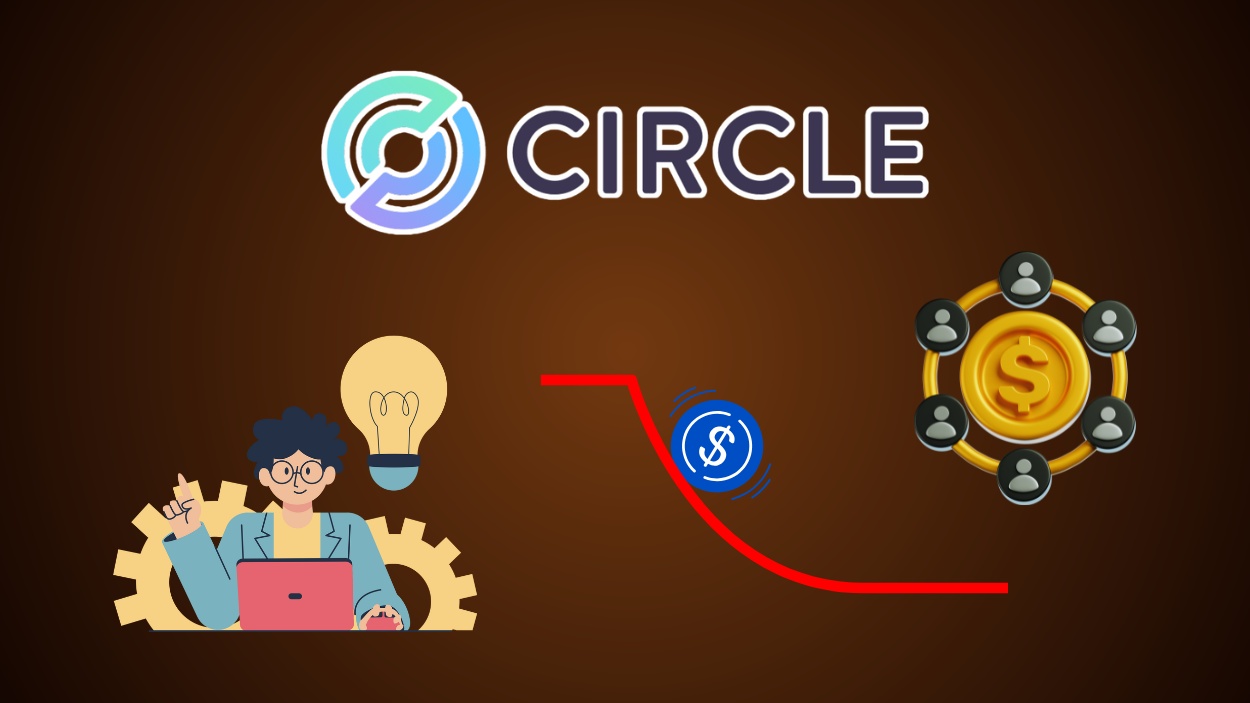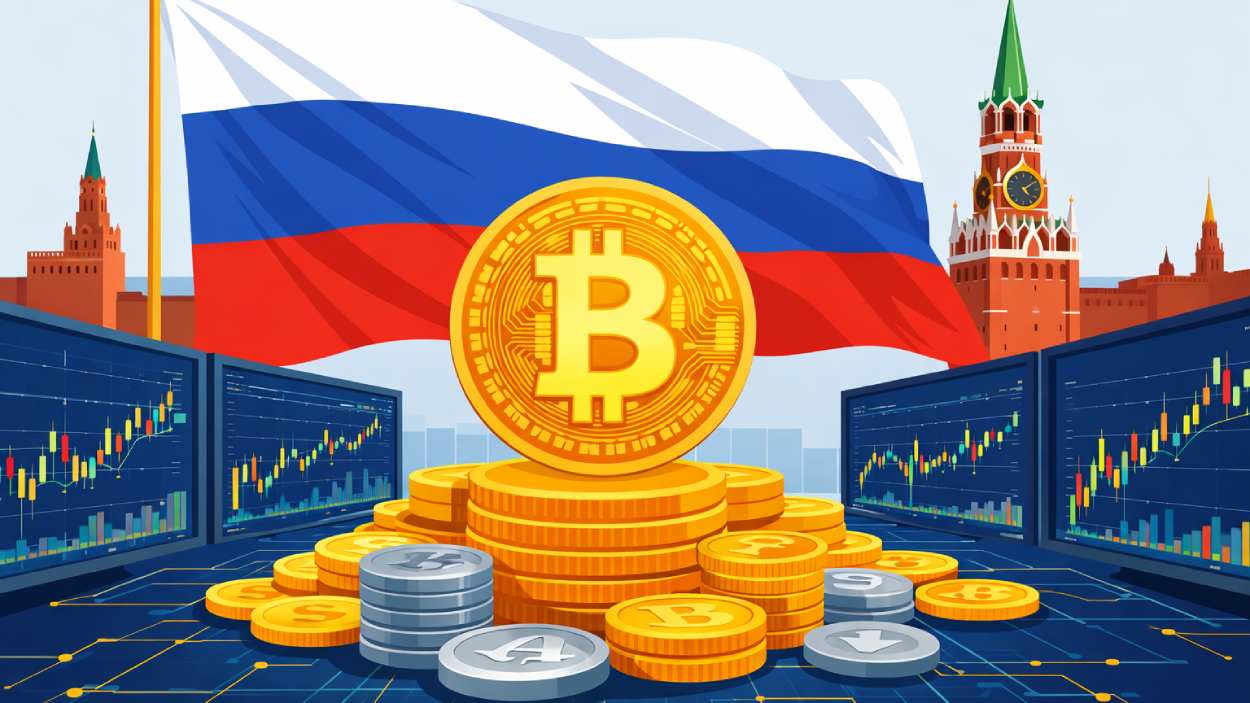Picture this: A 22-year-old college graduate lands her first full-time job, eager to manage her newfound income. But within months, she’s entangled in credit card debt and baffled by her 401(k) plan. Her story isn’t rare; in fact, it echoes the reality of millions across the globe. Financial literacy, or the lack thereof, continues to shape lives in subtle and dramatic ways. In 2025, as digital tools proliferate and financial products grow more complex, understanding basic financial concepts is no longer optional; it’s essential.
Editor’s Choice
- Only 27% of adults globally are considered financially literate in 2025, unchanged from the last major global survey.
- In the United States, 35% of Gen Z adults self-report low confidence in managing day-to-day finances.
- The gender gap in financial literacy persists: Women score 8 percentage points lower on average in financial literacy tests than men.
- 40% of U.S. high school seniors now take at least one semester of personal finance before graduation.
- Digital banking usage is at an all-time high, yet 25% of users struggle with understanding basic online financial tools.
- 60% of millennials carry credit card debt month-to-month, often due to a lack of budgeting skills.
- Countries with national financial education strategies saw a 12% higher rate of financial resilience during economic downturns.
Global Financial Literacy by Concept – Key Insights
- The overall financial literacy rate across surveyed populations stands at 57%, showing that just over half understand key financial concepts.
- Risk diversification is the most understood concept, with 69% of individuals answering related questions correctly.
- Inflation knowledge ranks second, with 63% of respondents demonstrating an understanding of how inflation affects purchasing power.
- Only 52% of people showed proficiency in numeracy, making it the least understood financial concept in the survey.
- Interest compounding is understood by 61%, indicating a moderate awareness of how money grows over time.
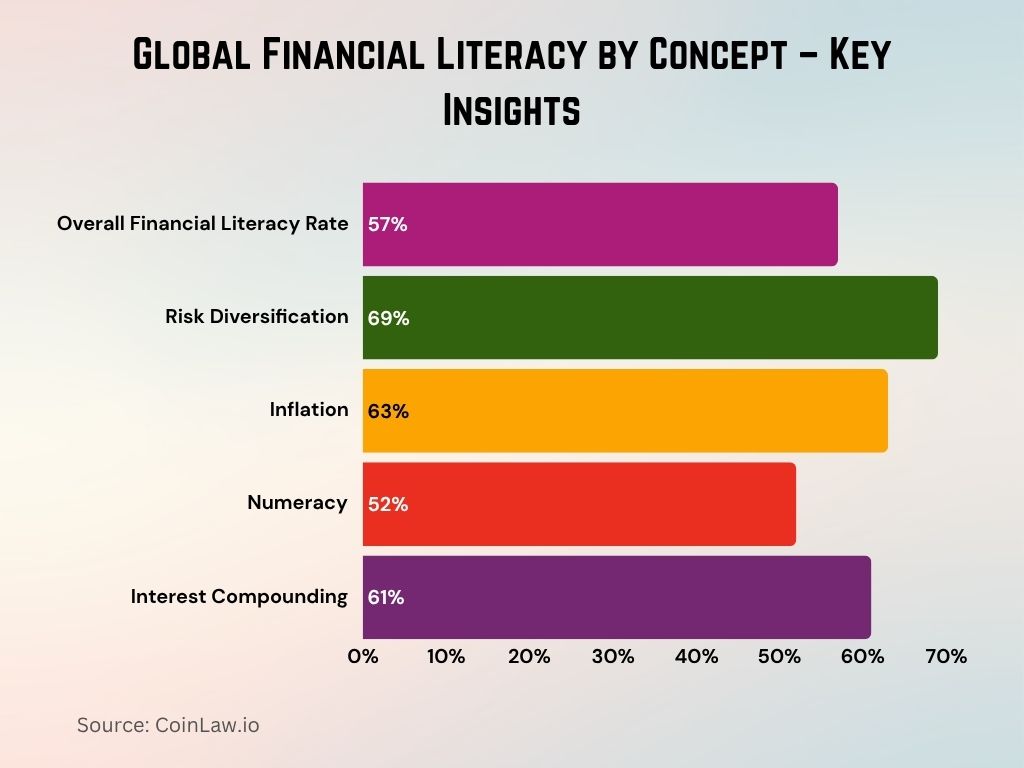
Gender Disparities in Financial Literacy
- Globally, men score 63%, while women score 55% on financial literacy assessments.
- Women are 33% more likely than men to defer financial decisions to a partner, citing lower self-confidence.
- In the U.S., the literacy gap narrowed slightly to 6 percentage points.
- Female entrepreneurs are twice as likely as their male counterparts to rely on informal lending due to a lack of financial knowledge.
- In India and Pakistan, women’s financial literacy rates are under 20%, linked to low digital access and educational disparities.
- Programs targeting financial education for mothers showed a 17% increase in household savings over two years.
- Only 12% of women globally invest in stocks or mutual funds, compared to 28% of men in 2025.
Financial Literacy in the United States
- In 2025, 57% of U.S. adults could answer at least three out of five financial literacy questions correctly.
- Alabama, Missouri, and Nebraska are now among the 25 states mandating personal finance courses for high school students.
- Racial disparities persist: Only 42% of Black Americans and 38% of Hispanic Americans are considered financially literate, compared to 61% of White Americans.
- 30% of American adults report they live paycheck-to-paycheck and don’t have a budget.
- Household debt in the U.S. reached $17.3 trillion, while only 38% of households regularly review their credit reports.
- In 2025, 41% of Americans said they would struggle to cover a $1,000 emergency expense.
- Despite rising digital access, 22% of U.S. adults say they don’t fully understand how credit scores are calculated.
- The average American retirement savings balance dropped to $76,000, largely due to the increased cost of living.
- Only 29% of Gen Z Americans invest in retirement accounts, compared to 47% of millennials and 69% of Gen Xers.
- Veterans who completed financial wellness programs were 35% more likely to maintain positive credit histories over 24 months.
The Impact of Early Financial Education – What Americans Believe
- 74% of Americans say they would’ve made fewer money mistakes if they had learned personal finance in high school.
- 73% believe they would be further ahead financially with early personal finance education.
- 76% feel they would’ve experienced less stress about money if taught financial skills during high school.
- In contrast, only 24%–27% of respondents disagree, highlighting a strong public desire for earlier financial education.

Financial Literacy Among Students and Young Adults
- In 2025, 43% of U.S. high school students say they’ve never been taught how to manage a bank account.
- College students carry an average credit card debt of $1,267.
- 72% of U.S. college students surveyed admitted to making financial decisions based on social media advice.
- Financial literacy scores among first-year college students dropped 3 points year-over-year, averaging 56% in 2025.
- Nearly 1 in 5 young adults in the U.S. have overdrafted their bank account at least once in the past year.
- Internationally, Singaporean students score the highest on OECD youth financial literacy tests, with an average of 78%.
- Only 18% of American 18–24-year-olds understand the long-term implications of student loan interest.
- Youth who took part in interactive financial simulation programs were 27% more likely to create a savings plan afterward.
- In the UK, 62% of university students expressed regret over taking on more student debt than necessary, due to a poor understanding of repayment terms.
- Financial anxiety among U.S. college students rose to 74%, correlating with both rising tuition and economic uncertainty.
Impact of Financial Education Programs
- School districts that implemented personal finance curricula saw a 16% increase in student budgeting behavior within one academic year.
- Adults who participated in nonprofit-led financial coaching programs were 44% more likely to reduce unsecured debt.
- In 2025, 43% of employers will offer voluntary financial education workshops.
- The Consumer Financial Protection Bureau (CFPB) reports a 9% drop in complaints related to debt collections among participants in financial education programs.
- Return on investment (ROI) for workplace financial literacy training averages $3 for every $1 spent, based on improved employee productivity and lower turnover.
- Prisoner re-entry programs that include financial education reduced recidivism by 12% in participating counties.
- Interactive app-based education programs like Zogo and EverFi saw user completion rates of over 85% in 2025.
- In Brazil, a national campaign for financial awareness in low-income schools led to a 22% increase in student savings behaviors.
- Among senior citizens, those who attended financial literacy workshops were 30% less likely to fall for financial scams.
- Only 13% of U.S. adults who received formal financial education believe they were adequately taught about investing and retirement planning.
Financial Literacy Rates by Age Group
- Young adults aged 18 to 24 have the lowest financial literacy rate at 35.2%, highlighting a major gap in early financial education.
- The rate increases to 42.4% for those aged 25 to 34, indicating gradual improvement with age and experience.
- Adults aged 35 to 44 show the highest literacy rate at 50.3%, suggesting peak understanding occurs in mid-life.
- Interestingly, the rate drops to 38.5% for the 45 to 54 age group, pointing to a dip in financial awareness during later working years.
- Among seniors aged 55+, the literacy rate rebounds to 49.2%, showing a near-peak comprehension in older age.
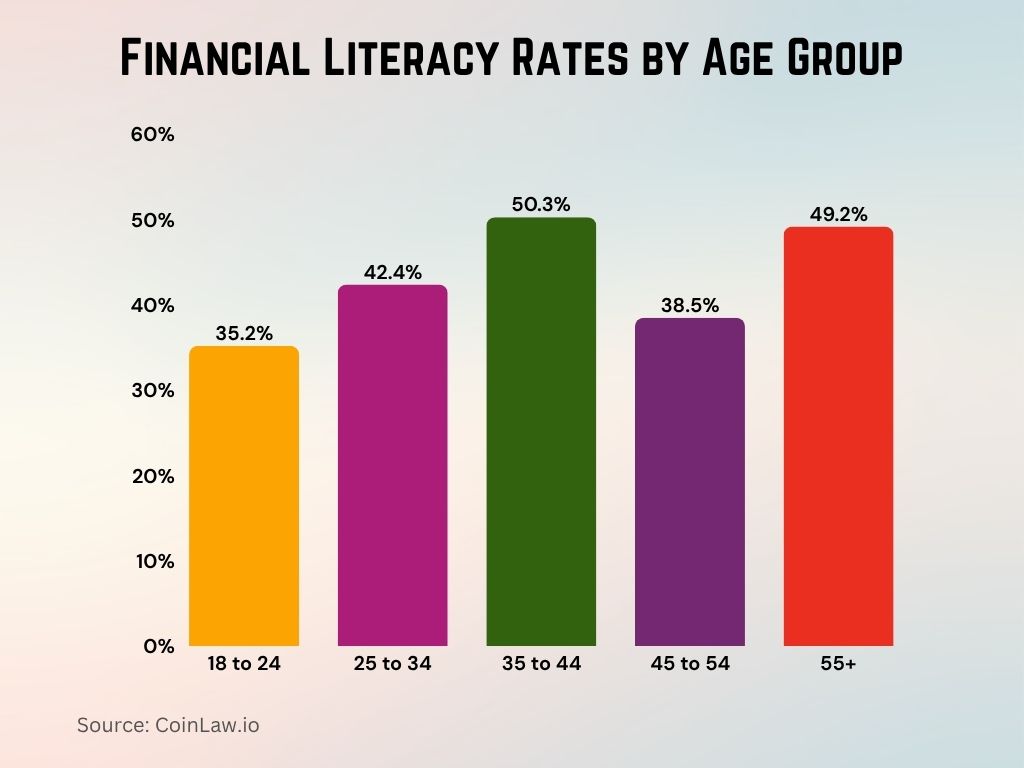
Financial Literacy in Low-Income Populations
- In 2025, only 23% of low-income U.S. adults are considered financially literate, compared to 56% of high-income individuals.
- 46% of low-income households report skipping medical treatment due to lack of funds and poor financial planning.
- Access to basic banking is still an issue, with 12.4% of low-income U.S. adults remaining unbanked.
- Households in the lowest income quintile are 3 times more likely to use payday loans.
- Community-based financial education programs raised budgeting proficiency by 21% among participants with incomes below the poverty line.
- SNAP recipients who received budget coaching were 28% more likely to reduce food insecurity within six months.
- Financial literacy interventions for public housing residents in Detroit resulted in a 14% increase in emergency savings.
- Only 18% of rural residents in developing nations use formal financial services, limiting their opportunities for savings and credit access.
- Single-parent households earning under $30,000 annually are less likely (by 31%) to own a retirement account.
- In Latin America, mobile literacy programs led by NGOs improved basic budgeting skills by 33% among informal workers.
Correlation Between Financial Literacy and Economic Stability
- Countries with high financial literacy (over 60%) showed 25% lower unemployment volatility during economic downturns.
- U.S. counties with stronger average financial literacy scores saw fewer foreclosures during the 2023–2024 economic slowdown.
- A World Bank study found a positive correlation of 0.68 between national financial literacy rates and GDP per capita.
- Households with emergency funds of three months or more are 2.5 times more likely to weather income shocks without taking on debt.
- Among U.S. adults, those who scored higher on financial literacy tests were 40% less likely to report financial stress.
- Countries with national savings rates above 30% all had average financial literacy rates exceeding 55%.
- Job retention in the service sector is 12% higher among employees who received workplace financial coaching.
- Small businesses led by financially literate owners were 30% less likely to fail in their first three years.
- A growing trend shows that financially literate households invest more in education and health, contributing to long-term social mobility.
- Economically stable nations like Switzerland and Singapore also top the charts in financial capability indices, reinforcing the cyclical link.
Global Financial Illiteracy – Countries With the Highest and Lowest Rates
- Guatemala and Nigeria have the highest financial illiteracy rates at 74% each, showing a widespread lack of financial knowledge.
- Other countries with over 70% financial illiteracy include Portugal (73%) and Thailand (72%).
- Latin American countries like Argentina (69%), Colombia (68%), Mexico (65%), and Brazil (65%) also rank high in financial illiteracy.
- Developed nations such as France (48%), Austria (47%), and Switzerland (43%) show lower rates, but still reflect notable gaps.
- The lowest financial illiteracy is seen in Sweden and Norway, both at just 29%, followed by the United Kingdom (33%) and Germany (34%).

Workplace Financial Wellness Trends
- In 2025, 58% of U.S. employers offer some form of workplace financial wellness program.
- Employees who engaged in these programs were 34% more likely to increase their retirement contributions.
- Financially stressed employees are absent 1.8 more days per year on average compared to financially confident peers.
- 78% of HR leaders report that financial literacy initiatives have improved overall job satisfaction.
- Paycheck-linked savings programs grew in popularity, with 1 in 4 employers offering automatic deductions into emergency funds.
- Workers under age 35 who participated in company financial bootcamps showed a 19% improvement in money management behaviors.
- Employee productivity increases by an estimated 11% when financial stress is reduced through employer resources.
- Large corporations like Target and Amazon expanded their financial mentoring benefits, covering up to 10 sessions annually per employee.
- A study showed that financially confident employees are two times more likely to stay at their jobs long-term.
- The healthcare and manufacturing sectors led the adoption of personal finance apps integrated into employee benefits.
Key Financial Literacy Statistics Among Adults
- 74% of adults believe they would have made better financial decisions in adulthood if taught financial literacy in school.
- 75% say they were never educated about finances during their schooling years.
- 9 out of 10 adults did not feel prepared to handle their personal finances after graduating from high school or college.
- A staggering 3.5 billion people globally do not understand basic financial concepts, highlighting a major global education gap.
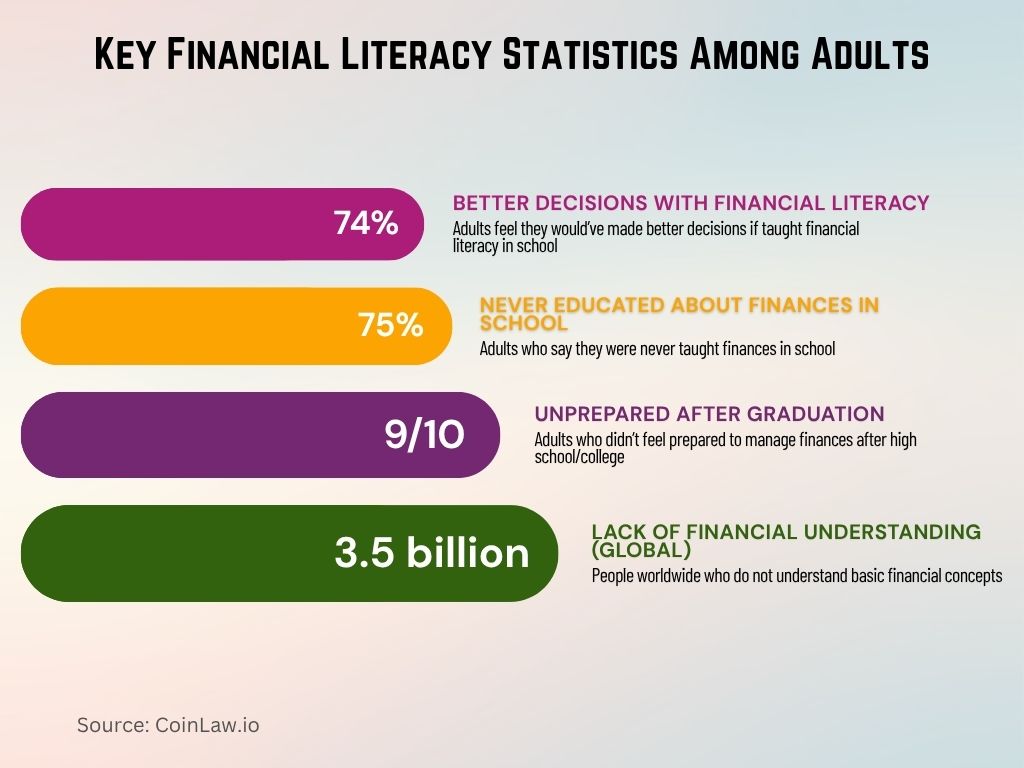
Government and NGO Initiatives Promoting Financial Literacy
- As of 2025, over 90 countries have national financial education strategies in place.
- The U.S. Financial Literacy and Education Commission introduced an AI-powered tool to tailor learning paths for citizens.
- Australia’s MoneySmart program reached 1.5 million users in 2025.
- In Canada, the FCAC updated its National Strategy for Financial Literacy with a stronger focus on digital tools for seniors.
- UNESCO partnered with Visa Foundation to launch a global youth financial challenge across 35 countries.
- In India, the RBI’s financial inclusion campaign brought 5.2 million rural residents into the basic banking systems.
- Kenya’s e-FinEdu program provides free financial education via SMS to more than 3 million mobile subscribers.
- The EU mandated financial transparency curricula in high school education across all member states beginning in 2025.
- In the U.S., the IRS expanded its taxpayer education initiative to cover crypto and gig economy incomes.
- NGOs like FINCA International and Women’s World Banking saw program retention rates above 85%, driven by localized, language-specific training.
Financial Literacy: Nontraditional Workers vs. U.S. Adults
- On calculating 2% interest over 5 years, 81.6% of nontraditional workers answered correctly vs. 72.5% of U.S. adults.
- When asked about inflation and purchasing power, 73.1% of nontraditional workers responded accurately compared to only 55.1% of U.S. adults.
- Regarding investment knowledge, 82.4% of nontraditional workers knew that a single stock is riskier than a mutual fund, while just 43.4% of U.S. adults answered correctly.
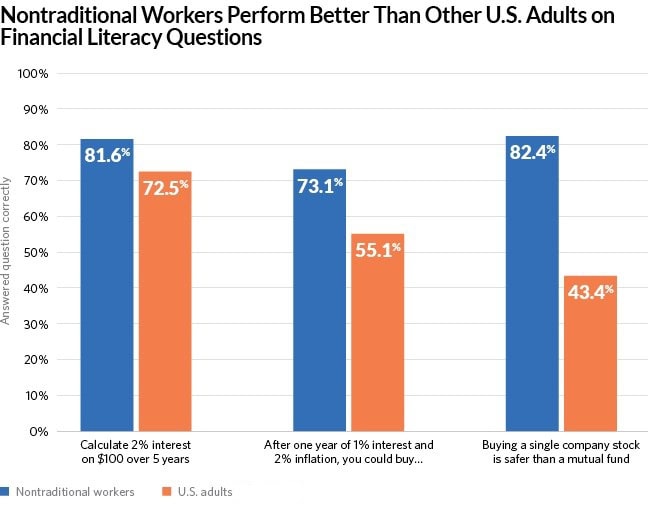
Recent Developments in Financial Literacy
- Gamification is now embedded in 62% of new personal finance tools released in 2025.
- TikTok and YouTube influencers with certified financial credentials grew their audiences by over 45% year-over-year.
- AI-driven financial coaches like Cleo and Albert now serve more than 12 million users in North America alone.
- Real-time spending insights are a top-rated feature in budgeting apps, used by 78% of Gen Z users.
- The Federal Reserve launched a new Financial Wellness Index to track household financial confidence quarterly.
- Crypto literacy remains low, with only 19% of retail investors understanding how to secure their digital assets.
- “Soft pull” credit monitoring apps surged in popularity, with Credit Karma alone adding 4 million users in the past year.
- Finfluencers are increasingly regulated, 3 countries now require disclaimers and licensing for finance creators.
- Financial literacy games designed for K-12 education, such as Banzai and Next Gen Personal Finance, reached nearly 10 million students in 2025.
- The concept of “financial well-being” is now part of the UN Sustainable Development Goals, formally acknowledged in 2025.
Conclusion
Financial literacy is no longer just a personal advantage; it’s a societal necessity. The 2025 data confirms a global pivot toward more inclusive, tech-driven, and behaviorally informed education. From classrooms and boardrooms to rural communities and smartphones, the world is waking up to the urgency of financial knowledge. While progress is steady, the journey ahead will depend on collaborative innovation and sustained commitment. For every individual, mastering money today could be the foundation of a more resilient tomorrow.


